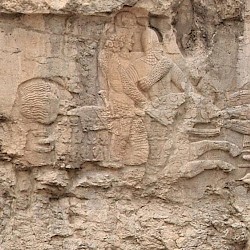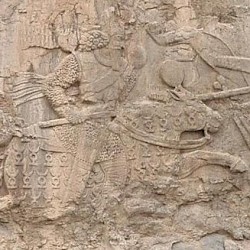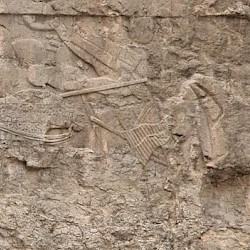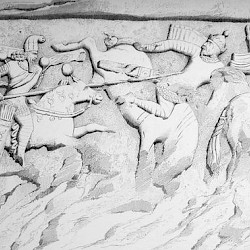Firuzabad, Relief I
Q558514Ardašir Khureh ("fame of Ardašir): Sasanian city in Persis, modern Firuzabad. Except for the city, there is a castle, a palace, a large relief celebrating Ardašir's victories (discussed on this page), and a small relief commemorating his investiture.
Firuzabad, Relief 1
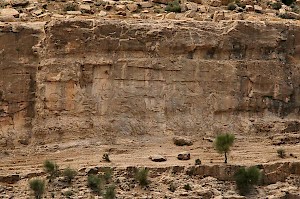
The equestrian relief of Firuzabad is hard to distinguish, because it is far from the road and badly damaged. Even when you know that it is near a bridge, even when you are looking for something no less than twenty meters wide, and even though there is a sign near the road, you will find it difficult to recognize. The drawing is, to be honest, better than the original.
The relief shows three stages in Ardašir's fight against the Parthian king Artabanus IV in 224. The Persian leader, who had united the southern part of modern Iran, had built Ardašir Khureh, and Artabanus was worried about Ardašir's increasing power. When he arrived with an army, however, he was defeated by his rebellious vassal and the Persian became the new "king of kings". This was the beginning of the rule of the Sasanians, which was to last until the rise of Islam in the seventh century.
On the first scene, a Persian seizes his Parthian opponent and has his arm around his enemy's head. This scene, in the center, shows how Ardašir's son Shapur unseats Artabanus' vizier. Note the fine armor of the rider and the horse.
Finally, the fight between the two kings: Ardašir defeats Artabanus, whose horse turns a somersault. The victorious new king attributed his success to the god Ahuramazda, which is the subject of the second relief.
The equestrian relief is the oldest and largest of all Sasanian rock reliefs. Its lively style was not copied and Sasanian art remained a bit static, until Bahram II (r.276-293) ordered his Equestrian Victory Relief at Naqš-e Rustam.
Literature
- Louis Vanden Berghe, Reliefs rupestres de l' Iran ancien (1983 Brussels), catalog #50
